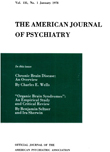CLINICAL OBSERVATIONS OF THERAPEUTIC EFFECT OF CHLORPROTHIXENE (TARACTAN) IN PSYCHOSES
Abstract
Sixty psychotic patients have been treated with chlorprothixene for 8 to 32 weeks; most of the patients were chronic schizophrenics. Twenty (40%) schizophrenics improved or achieved a remission to be released for convalescent care; 13 (26%) improved sufficiently to participate in hospital social, occupational and recreational activities and 17 (34%) remained unimproved. The number of non-schizophrenic patients was too small to be statistically signfficant. Frequent blood counts and transaminase studies revealed no significant abnormalities; there were no cases of agranulocytosis, jaundice or skin rash; mild extrapyramidal symptoms developed in 2 patients, but were easily controlled with Akineton, and did not require discontinuation of chlorprothixene.
Both tranquilizing and antidepressant effects are gradual; no dramatic changes have been observed.
Chlorprothixene might be useful in treatment of schizophrenic patients who have some depressive features, or become depressed from large doses of other tranquilizers.
Access content
To read the fulltext, please use one of the options below to sign in or purchase access.- Personal login
- Institutional Login
- Sign in via OpenAthens
- Register for access
-
Please login/register if you wish to pair your device and check access availability.
Not a subscriber?
PsychiatryOnline subscription options offer access to the DSM-5 library, books, journals, CME, and patient resources. This all-in-one virtual library provides psychiatrists and mental health professionals with key resources for diagnosis, treatment, research, and professional development.
Need more help? PsychiatryOnline Customer Service may be reached by emailing [email protected] or by calling 800-368-5777 (in the U.S.) or 703-907-7322 (outside the U.S.).



